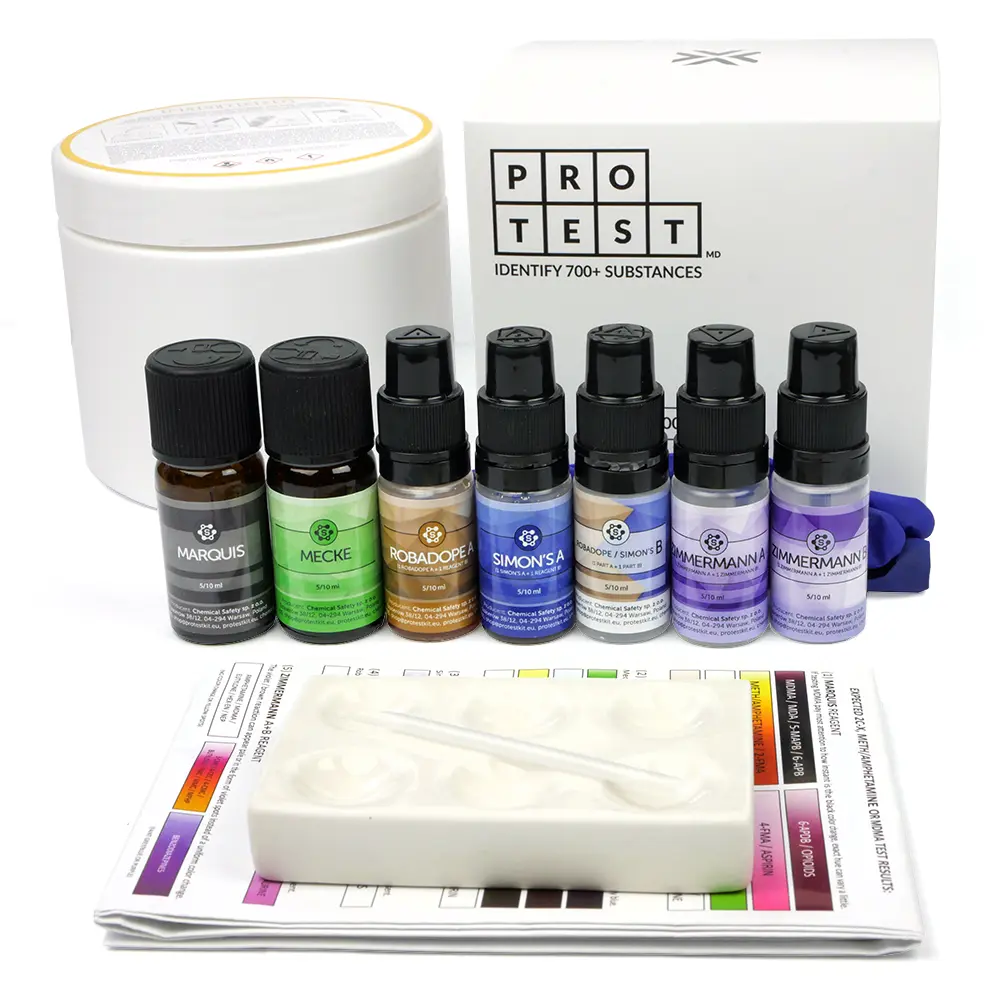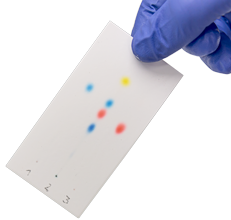INSTRUCTIONS How to detect meth/amphetamine mixed in MDMA?
If a sample is adulterated and contains more than 1 ingredient then reagent tests usually can only indicate or rule out presence of an ingredient with the darkest color change reaction. That is because multiple reactions happening at the same time will most of the time blend together.
What makes analysis even harder is the fact that exact reaction hue always varies a little depending on sample adulteration, quantity, lighting, temperature, exposure to air, storage, testing surface as well as reagent quality and degradation.
Last but not least, there is much more psychoactive compounds (800+ in our database) than distinct colors so it is highly recommended not to overinterpret inconclusive results but rather to fall back to the following guidelines instead:
- Always try to use multi-reagent test kits instead of a single reagent test
- To detect cuts use reagents that do not react with the expected compound
- To detect all ingredients and estimate potency use a TLC substance purity test kit
- Do not trust amphetamine test strips – these have not been extensively field tested
The best test kit for MDMA
We are proud to offer the most comprehensive reagent test kit for MDMA on the market. Not always as many reagents as possible is best which is why we offer tailored kits based on always up-to-date black market analysis.
PRO Test MDMA test kit features 5 reagents: Marquis, Mecke, Simon’s, Robadope and Zimmermann. The kit is best for MDMA, MDA, meth/amphetamine, benzodiazepines, cathinones, 2C-B and more.
-
To confirm presence of MDMA use Marquis, Mecke and Simon’s reagents which should turn instantly black (Marquis and Mecke) or dark blue (Simon’s)
- To rule out presence of specific cuts use Robadope reagent (for primary amines such as amphetamine) or Zimmermann (for most cathinones and benzos)
The best reagent test for detecting amphetamine in MDMA
The most reliable way to check if MDMA contains amphetamine (not methamphetamine) is to first confirm presence of MDMA with relevant kit, then use Robadope reagent test. Robadope (also known as Robatest):
- Does not react to MDMA but turns pink with all primary amines, such as amphetamine, 2C-B, PMA, MDA, taurine
- Reacts with pink color change to a range of primary amines its negative result (no pink color change) rules out presence of amphetamine
The best test kit for detecting meth/amphetamine in MDMA
Hands down the most reliable home testing method to detect any and all ingredients present in a sample is TLC (Thin Layer Chromatography). While a little bit more complex than reagent tests, still at a fraction of a lab analysis cost TLC allows anyone to check purity of a desired compound.
How it works is rather simple, different compounds behave differently with solvents so by soaking a TLC testing “card” substances travel various lenght and separate as a result.
First use a reagent test kit to make sure what you are working with. Different compounds might require different TLC testing liquid. It is always best to pair different testing methods for more clear reading.
TLC Purity Test analysis
How to detect meth mixed in MDMA using reagent tests alone?
According to drugsdata.org a considerable amount of ecstasy pills (particularly on the US market) contains MDMA mixed with methamphetamine, of which there is an abundance in North America. Because reagent testing confirmes or rules out presence of specific compounds, not purity, such pills can fool tests to an inexperienced eye.
Unlike with Robadope test for amphetamine, methamphetamine is a secondary amine just like MDMA meaning it can’t be as easily selectively tested. Fortunately thanks to many customer submissions and available reference data we have established a protocol how you can clearly rule out any significant (20%+) admixture of meth in MDMA using only reagent tests:
- Choose a reagent that reacts with MDMA/MDA but has a faint/no reaction with meth/amphetamine: Mecke or Froehde
- Chooose a reagent that reacts both with MDMA/MDA and meth/amphetamine: Marquis or Liebermann
- Use at least 1 of each to test your product and observe if both samples turn black equally fast. MDMA should turn Mecke, Froehde, Marquis and Liebermann reagents completely black in about 2-3 seconds.
Do not guess if other compounds can be detected this way, it’s best to assume 1 test = 1 reaction.
Remember: using multiple reagents have multiple serious advantages over testing with just 1 reagent.
Methamphetamine mixed with MDMA (2:5 ratio)
Reagents presumptively indicate PRESENCE, but not QUANTITY. To detect all ingredients and estimate potency it’s required to use an additional purity test kit. A positive or negative test result does not indicate if the substance is safe. No substance is 100% safe.


